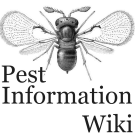Publications for:
pest = Phragmites australis (weed)
country = U.S.A. (NE)
found 30 publications:2023
Citizen science and land use data provide insight into the invasive riparian plant composition of the Hudson River Valley watershedInvasive Plant Science and Management (2023) 15 (4), 174-182
publishers website - pestinfo wiki
2022
Novel genome characteristics contribute to the invasiveness of Phragmites australis (common reed)Molecular Ecology (2022) 31 (4), 1142-1159
publishers website - pestinfo wiki
2021
Performance of a native butterfly and introduced moth on native and introduced lineages of Phragmites australisInsects (2021) 12 (12 - 1102)
publishers website - pestinfo wiki
2020
Competition among native and invasive Phragmites australis populations: An experimental test of the effects of invasion status, genome size, and ploidy levelEcology and Evolution (2020) 10 (3), 1106-1118
publishers website - pestinfo wiki
2018
Management of invasive Phragmites australis in the Adirondacks: a cautionary tale about prospects of eradicationBiological Invasions (2018) 20 (1), 59-73
publishers website - pestinfo wiki
Grazer deterrence and fungal inhibition by the invasive marsh grass Phragmites australis and the native sedge Bolboschoenus robustus in a mesohaline marsh
Chemoecology (2018) 28 (6), 163-172
publishers website - pestinfo wiki
Living in two worlds: Evolutionary mechanisms act differently in the native and introduced ranges of an invasive plant
Ecology and Evolution (2018) 8 (5), 2440-2452
publishers website - pestinfo wiki
Impacts of Phragmites australis invasion on soil enzyme activities and microbial abundance of tidal marshes
Microbial Ecology (2018) 76 (3), 782-790
publishers website - pestinfo wiki
Competitive interactions between native Spartina alterniflora and non-native Phragmites australis depend on nutrient loading and temperature
PLoS ONE (2018) 13 (2 - e0192234)
publishers website - pestinfo wiki
2017
Soil conditioning effects of Phragmites australis on native wetland plant seedling survivalEcology and Evolution (2017) 7 (15), 5571-5579
publishers website - pestinfo wiki
2016
Microsatellite DNA analysis of spatial and temporal population structuring of Phragmites australis along the Hudson River EstuaryBiological Invasions (2016) 18 (9), 2517-2529
publishers website - pestinfo wiki
Biogeographic gradients in ecosystem processes of the invasive ecosystem engineer Phragmites australis
Biological Invasions (2016) 18 (9), 2577-2595
publishers website - pestinfo wiki
Local and regional disturbances associated with the invasion of Chesapeake Bay marshes by the common reed Phragmites australis
Biological Invasions (2016) 18 (9), 2661-2677
publishers website - pestinfo wiki
Diversity of fungal endophytes in non-native Phragmites australis in the Great Lakes
Biological Invasions (2016) 18 (9), 2703-2716
publishers website - pestinfo wiki
Archaeal rhizosphere communities differ between the native and invasive lineages of the wetland plant Phragmites australis (common reed) in a Chesapeake Bay subestuary
Biological Invasions (2016) 18 (9), 2717-2728
publishers website - pestinfo wiki
2015
Virulence of oomycete pathogens from Phragmites australis-invaded and noninvaded soils to seedlings of wetland plant speciesEcology and Evolution (2015) 5 (11), 2127-2139
publishers website - pestinfo wiki
2014
Preadaptation and post-introduction evolution facilitate the invasion of Phragmites australis in North AmericaEcology and Evolution (2014) 4 (24), 4567-4577
publishers website - pestinfo wiki
Managing remnant and reemerging common reed (Phragmites australis) infestations to improve treatment efficacy and mitigate damage to native plants
Invasive Plant Science and Management (2014) 7 (3), 445-453
publishers website - pestinfo wiki
2013
Impacts of plant invasions can be reversed through restoration: a regional meta-analysis of faunal communitiesBiological Invasions (2013) 15 (8), 1725-1737
publishers website - pestinfo wiki
Soil pathogen communities associated with native and non-native Phragmites australis populations in freshwater wetlands
Ecology and Evolution (2013) 3 (16), 5254-5267
publishers website - pestinfo wiki
2011
Mechanisms of Phragmites australis invasion: feedbacks among genetic diversity, nutrients, and sexual reproductionJournal of Applied Ecology (2011) 48 (5), 1305-1313
publishers website - pestinfo wiki
Palatability and chemical defense of Phragmites australis to the marsh periwinkle snail Littoraria irrorata
Journal of Chemical Ecology (2011) 37 (8), 838-845
publishers website - pestinfo wiki
2010
Hybridization of invasive Phragmites australis with a native subspecies in North AmericaBiological Invasions (2010) 12 (1), 103-111
publishers website - pestinfo wiki
Molecular data provide strong evidence of natural hybridization between native and introduced lineages of Phragmites australis in North America
Biological Invasions (2010) 12 (9), 2967-2973
publishers website - pestinfo wiki
2009
Native and invasive plant interactions in wetlands and the minimal role of invasivenessBiological Invasions (2009) 11 (8), 1929-1939
publishers website - pestinfo wiki
2008
Common reed (Phragmites australis) response to mowing and herbicide applicationInvasive Plant Science and Management (2008) 1 (1), 12-16
publishers website - pestinfo wiki
2007
Interactions between the grass shrimp Palaemonetes pugio and the salt marsh grasses Phragmites australis and Spartina alternifloraBiological Invasions (2007) 9 (1), 25-30
publishers website - pestinfo wiki
1999
Species composition and inter-annual dynamics of a freshwater tidal plant community following removal of the invasive grass, Phragmites australisBiological Invasions (1999) 1 (2-3), 115-127
publishers website - pestinfo wiki
Microscale spatial distribution of Phragmites australis (common reed) invasion into Spartina patens (salt hay)-dominated communities in brackish tidal marsh
Biological Invasions (1999) 1 (2-3), 137-148
publishers website - pestinfo wiki
A paleoecological assessment of Phragmites australis in New England tidal marshes: Changes in plant community structure during the last few millennia
Biological Invasions (1999) 1 (2-3), 149-158
publishers website - pestinfo wiki
